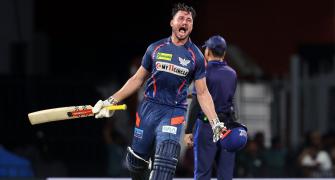Greek athletes at the ancient Olympics ate sheeps' testicles to raise their testosterone level. Others combined wine with strychnine, a poison used as a stimulant in small amounts.
Strychnine was still in vogue when the Games were revived in 1896 and the 1904 Olympic marathon gold medallist Thomas Hicks used it in combination with brandy during the race. It took four physicians to revive him after his victory.
Cyclists, in particular, during the late 19th century resorted to stimulants to enhance performance and numb the pain.
Heroin and cocaine were combined in a speedball. A less potent concoction mixed wine with extracts from the coca leaf.
Doping as a term appeared in an English dictionary in 1889 and as a scientific aid to performance in 1935 when German scientists isolated the male sex hormome testosterone, the key ingredient in increasing muscle strength.
Testosterone was injected into Nazi troops to increase their aggression and fed to German athletes at the 1936 Berlin Olympics where stimulants in the form of amphetamines were also in use.
SPONSORED DOPING
State-sponsored doping began in earnest after World War Two when the eastern bloc communist nations gave sport a prominent place on the ideological battlefield.
With the stakes raised a search began for a synthetic drug which would reproduce the effects of testosterone. This ended in 1955 when John Ziegler, physician for the U.S. weightlifting team, developed the first anabolic steroid.
Steroids served a legitimate medical function. Patients with wasting diseases were revitalised by drugs which stimulated the synthesis of protein, the key ingredient of muscle, bone and skin.
But their attractions to those seeking a quick fix were obvious.
Athletes, whether subjected to a state-controlled regime as in the Soviet Union or East Germany, or acting independently in the west, found they could train longer and recover quicker when using steroids.
Those gripped by the Californian cult of the body beautiful were able to resculpture themselves, often with extreme and grotesque results.
Amphetamines, which stimulate the nervous system and ward off fatigue, became immensely popular for all sorts of pursuits, including sport, study and long distance lorry driving.
At the 1960 Olympics, Danish rider Knut Jensen collapsed and died as a result of a combination of nicotinic acid and amphetamines.
In 1967 Britain's Tommy Simpson died during a brutal climb in the Tour de France. A vial containing an amphetamine was found on his body.
STEROIDS ABOUND
During the 1960s
Responding to a danger threatening to distort their sport, the world governing athletics body banned steroids im 1975, two years after a test had been developed by Briton Raymond Brooks.
Crucially, though, tests were conducted only during competitions. Any athlete with any sense, or with access to intelligent advisers, realised that the benefits of the strength gained by steroids came during pre-competition training and simply stopped taking drugs well before championships.
Drug-taking proliferated during the 1980s in both men's and women's athletics events. Women benefitted even more than men from steroids because testosterone radically changed their bodies, sometimes with alarming effects.
It was not until Canadian Ben Johnson tested positive for the anabolic steroid stanozolol after winning the 1988 Seoul Olympic 100 metres final that the magnitude of the problem became apparent to the world at large.
A Canadian government inquiry in the following year revealed in chilling detail the extent of drug-taking in the small group run by coach Charlie Francis. Francis, banned for life by his national federation, said he would be failing in his duty as a coach if his charges has not taken drugs.
"Athletes are no better or worse than the societies from which they come," he wrote. "Their nations clamour for glory. Their sponsors reward success. They are expected to win and yet remain drug-free -- goals that have become increasingly incompatible over the last 20 years."
In 1989, the International Association of Athletics Federations introduced random testing. World records in 12 women's Olympic events remain unchanged since that date.
Since Johnson there have been major drug cases in swimming when seven Chinese swimmers tested positive for steroids at the 1994 Asian Games and four years later in the Tour de France when the Festina team were expelled after customs officers discovered a car full of drugs.
Potentially the greatest scandal erupted last year with the fortuitous discovery of a new steroid in California. Five people, including double world champion Kelli White, have since been banned.
Those who believe the problem can be confronted and contained - if not completely eradicated due to the fallibilities of human nature - place their faith in the new World Anti-Doping Agency (WADA), set up in 1999.
"You are never going to stop a small percentage of society from cheating," WADA president Dick Pound told Reuters this year.
"Society needs its police forces and its courts' systems and we need to the ability to sanction. That's part of society and we just run our little part of it."









